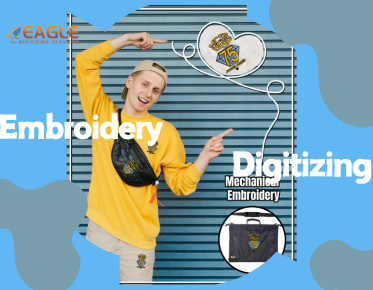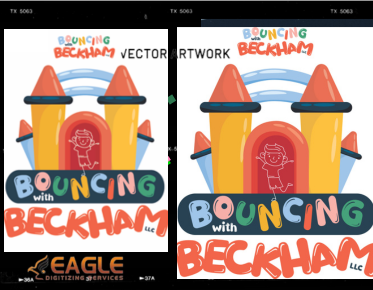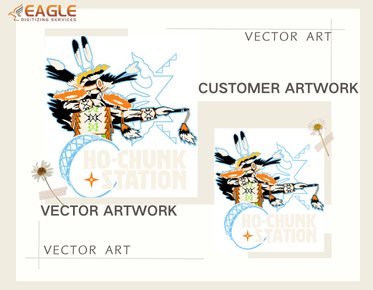The Future of Crafting: Laser Embroidery Explained
Laserembroidery is nothing short of a revolution in the world of textile arts.
Merging advanced laser technology with the centuries-old craft of embroidery,
it brings a new level of precision and creativity to fabric decoration. This
innovative process allows artists, designers, and manufacturers to create
intricate patterns, sharp lines, and flawless designs with remarkable speed.
It’s a game-changing technique that’s redefining what’s possible in textile
embellishment.
Why Laser Embroidery Is Changing the Game in Textile Art
Traditional
embroidery has long been beloved for its tactile, handcrafted charm. Yet, the
rise of laser embroidery has introduced an entirely new dimension, where
technology enhances the craft rather than replacing it. With the power to
quickly transform complex digital designs into beautifully stitched works of
art, laser embroidery is reshaping fashion, home décor, and promotional
products alike. Its efficiency, scalability, and unmatched precision make it a
compelling tool for creatives and industries worldwide.
What Exactly is Laser Embroidery?
Understanding
the Basics: A New Spin on Traditional Embroidery
Laser embroidery
combines the art of stitching with the cutting-edge power of lasers to achieve
detailed, decorative effects on fabric. Unlike conventional embroidery, which
requires thread and a needle, laser embroidery uses high-powered lasers to
burn, etch, or engrave designs into the fabric. The result is an intricate,
sometimes 3D effect that can be applied to virtually any textile. This technology
allows for designs that were once impossible or time-consuming to create by
hand.
How
Laser Technology Enhances the Art of Stitching
Lasers are
incredibly precise tools, capable of cutting or engraving with such accuracy
that even the most delicate details come to life. With the right laser
settings, you can create sharp, clean edges without the risk of fraying fabric.
This precision allows for more complex and detailed designs that would be
difficult, if not impossible, to achieve with traditional embroidery methods.
Plus, the consistency of the laser means every design is identical, no matter
how many times it’s repeated.
How Laser Embroidery Works
Breaking
Down the Laser Process: More Than Just a Machine
At its core,
laser embroidery works by utilizing a laser beam to make precise cuts or
etchings in fabric. The fabric is fed into a laser machine, which uses computer
programming to follow a design pattern. The laser’s heat causes the fabric to
either melt or burn away, leaving behind a beautifully crafted design. Whether
it's intricate patterns, lettering, or graphics, the laser essentially "stitches"
by removing parts of the fabric in a controlled, detailed manner. It’s more
than just a machine – it’s a fusion of technology, art, and precision engineering.
Step-by-Step:
From Design to Stitched Fabric
Making a digital
design is the first step in the process. This design is then uploaded to the
laser machine’s software, which converts the image into a file the machine can
understand. The fabric is carefully placed on the machine bed, ensuring it’s
secure. The laser then begins its work, either cutting or engraving along the
path dictated by the design file. This process is repeated until the entire
design is completed. The result is a flawless, intricate embroidery-like effect
without a single thread in sight.
Laser vs. Traditional Embroidery: What’s the Difference?
The
Speed and Precision of Lasers vs. Handcrafted Stitches
One of the
biggest differences between laser embroidery and traditional methods is speed.
Laser machines can complete designs in a fraction of the time it would take to
manually stitch them. This makes laser embroidery ideal for mass production or
when a quick turnaround is needed. Precision is another advantage. Lasers can
cut with such fine detail that even the most complex designs are rendered with
exact accuracy, something that is difficult to replicate by hand.
Comparing
Materials: What Works Best for Each Technique
While traditional
embroidery can be done on virtually any fabric, it excels on textiles that are
relatively easy to puncture with a needle, such as cotton or linen. Laser
embroidery, on the other hand, is better suited for a wider range of materials,
including synthetic fabrics, leather, and thicker textiles, where stitching by
hand could be challenging. The laser's heat and precision allow it to work on
materials that traditional embroidery may struggle with, like heavy fabrics or
items with complex cuts.
The Tools Behind Laser Embroidery
Key
Machines and Equipment Used in Laser Embroidery
Laser embroidery
requires specialized equipment, with the main component being the laser cutting
machine. These machines are typically equipped with CO2 lasers that are
powerful enough to cut through a variety of fabrics. Additionally, the software
used to control the laser is essential for translating the design into the
precise cut or engraving. Other tools might include rotary blades for
additional cutting effects, fabric stabilizers to hold the fabric in place, and
specialized lighting to enhance the visibility of the intricate details being
created.
Understanding
the Role of Lasers, Software, and Fabrics
The laser itself
is the most vital tool in the process, delivering the necessary energy to burn
or cut fabric. However, it’s the combination of software that defines the
design and the fabric choice that dictates the final outcome. The software
ensures the laser cuts exactly along the lines of the design, while the fabric
needs to be compatible with laser technology to ensure clean edges and prevent
fraying. When all these elements work in harmony, the result is a beautifully
crafted piece of textile art.
Types of Laser Embroidery Designs
Intricate
Patterns vs. Bold Graphics: What Can Be Created
Laser embroidery
opens up a world of design possibilities. It’s ideal for creating both
delicate, intricate patterns and bold, graphic imagery. Whether you're looking
for fine lace-like designs, geometric patterns, or large-scale,
attention-grabbing graphics, laser embroidery can handle it all. The laser’s
precision allows even the most intricate details to be captured flawlessly,
making it perfect for everything from wedding dresses to corporate logos.
Customizing
Laser Embroidery for Unique Creations
Laser embroidery
is particularly popular for customization. Designers can take a basic design
and modify it, adding unique elements to make each piece one-of-a-kind.
Personalizing fabric with names, logos, or custom patterns is a breeze, making
it a popular choice for everything from fashion and accessories to home décor
and promotional merchandise.
The Advantages of Laser Embroidery
Speed
and Efficiency: Getting More Done in Less Time
Laser embroidery
dramatically cuts down the time required to complete intricate designs. Where
traditional hand embroidery might take hours or even days, laser embroidery can
finish the same design in mere minutes. This efficiency makes it an excellent
option for large-scale projects, such as mass-producing promotional products or
creating custom clothing lines.
Precision
and Accuracy: Perfect Stitches Every Time
The laser’s
precision ensures that every cut is exact, with no variation from one piece to
the next. This accuracy is crucial in designs that require uniformity, such as logos,
text, or highly detailed patterns. The consistent results make laser embroidery
an excellent choice for high-end fashion designers and manufacturers alike,
where quality control is key.
The
Ability to Handle Complex Designs with Ease
Laser embroidery
excels in creating complex designs that would be difficult or time-consuming to
achieve by hand. Whether it's multi-layered textures, fine details, or
large-scale graphics, the technology allows for effortless creation of
intricate designs. Designers can push the boundaries of creativity, exploring
new textures, shapes, and patterns that were previously impossible or
labor-intensive with traditional methods.
Materials and Fabrics Suitable for Laser Embroidery
What
Materials Work Best with Laser Technology?
Laser embroidery
works on a wide range of materials, including cotton, denim, leather,
synthetics, felt, and even some plastics. The ability of the laser to cut
through fabrics with precision means that thicker materials, like leather or
canvas, can be embroidered with ease—something that traditional hand embroidery may struggle with. Additionally,
materials that fray easily can benefit from laser cutting, as the laser seals
the edges as it cuts, preventing unraveling.
From
Cotton to Leather: Exploring Fabric Options for Laser Stitching
When selecting
fabric for laser embroidery, it’s essential to consider the material’s
properties. Natural fabrics like cotton and linen work well, as they respond to
the heat of the laser in a controlled manner. However, for something more
robust like leather, the laser can create beautiful etchings and cuts without
damaging the material. Synthetic fabrics also work well, and the variety of
textures and weights available means the possibilities for laser embroidery are
virtually endless.
Environmental Impact: Is Laser Embroidery More Sustainable?
Reducing
Waste: How Laser Embroidery Minimizes Fabric Scraps
Unlike
traditional embroidery, which often produces a significant amount of waste from
thread and fabric offcuts, laser embroidery can be more sustainable. The
precision of the laser ensures that only the necessary parts of the fabric are
used, reducing waste and ensuring a cleaner process overall. Additionally,
laser cutting often seals the edges of fabrics, which can prevent fraying and
reduce the need for excess material.
Energy
Consumption: Comparing Laser and Traditional Embroidery Techniques
While the laser
machines do consume electricity, the overall energy use is typically lower than
that of traditional embroidery machines, which require significant mechanical
energy to operate. Furthermore, the efficiency of laser embroidery means that
projects are completed more quickly, reducing the energy needed for prolonged
work.
The Challenges of Laser Embroidery
Limitations
of Laser Embroidery in Certain Fabric Types
Laser embroidery
isn’t without its challenges. Some fabrics, particularly those that are very
light or have a high level of synthetics, can be difficult to work with. They
may burn too easily or melt, leading to undesirable results. It’s crucial to
test the material before using it for laser embroidery to ensure the best
outcome.
The
Cost of High-End Laser Equipment
Another potential barrier to entry is the cost of high-end laser embroidery machines. These machines can be expensive, making them an investment for businesses or professional designers. However, as the technology becomes more accessible, prices are expected to continue to fall, allowing more creators to incorporate laser embroidery into their work.
How to Get Started with Laser Embroidery
Finding
the Right Equipment for Your Projects
Getting started
with laser embroidery requires finding the right equipment for your needs.
Depending on the scale of your projects, you might choose a smaller desktop
model for personal use or a larger industrial machine for business
applications. You must also consider the types of materials you'll be working
with, the complexity of the designs, and your budget.
Basic
Skills and Knowledge Needed for Beginners
For beginners,
learning the basics of embroidery and laser
technology is key. Familiarity with design software is also a must, as this
will allow you to create and edit designs before sending them to the machine.
There’s a learning curve, but once you master the tools, the possibilities are
endless.
With its efficiency, precision, and ability to handle complex designs, laser embroidery is poised to continue shaping the world of textile design. As technology evolves, so too will how it can be used, opening up new avenues for innovation and artistic expression.



